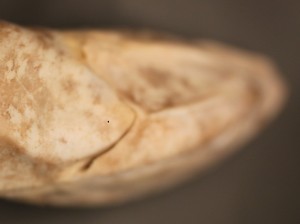Picture of OSUM Study Specimen Monopterus alba (you’re not missing much, the cryptically camouflaged live specimens are normally not much more colorful!)
The Asian Swamp Eel is known to occur as a native fish species throughout much of southeastern Asia, including India, China, Japan, Malaysia and Indonesia. There are reports of sightings of Asian Swamp Eels from several other countries in the vicinity including Australia. The species is now established in several countries outside their native range in western Africa, South, Central and North America. Populations are established in the United States; first in Hawaii, then in Georgia and most recently in Florida. Possible modes of invasion include escape from aquaculture ponds where the eels are raised for food.
Swamp eels are known as one of several fish species named as a source of a nematode parasite that causes human gnathostomiasis. The roundworm nematode must be ingested by the human host for successful infestation, but thoroughly cooking or freezing the intermediary host will kill the parasites. Thus it is inadvisable to use the swamp eels for sushi!
Other than being a host for a human parasite it is currently thought that the Asian Swamp Eel is relatively benign as far as their impact on local ecosystems, unlike some other more deleterious invasives. Although they are recognized as a pest neither the federal nor state regulatory agencies in the U.S. restrict the possession or culture of the Asian Swamp Eel.
According to the USGS the potential exists for establishment across the southern U.S. since they can survive relatively cold climates. Asian Swamp Eels are primarily nocturnal, making their movements hard to detect as well as difficult to prevent. They prey on small animals like fish, crayfish, worms, snails and aquatic insects but also feed on detritus. One of several characteristics that enable this species to invade new territories is their ability to breath air, allowing them to occupy ephemeral water bodies, burrowing into wet earth during the dry seasons, and to move across land (it is likely that the swamp eels behave like lungfish in creating a cocoon of mucous that serves to retain moisture, since they are able to secrete copious amounts of of the slimy material). Given they are air breathers application of chemicals like Rotenone that removes oxygen from the water would not be an effective control.
The skin of the larvae is highly vascularized so the young individuals use their large pectoral fins to pass water over their skin. As the larvae mature they lose the pectoral fins as well as permeability of most of the external tissues. Adults retain the vascularity of the skin of their mouths and throat linings and develop an air breathing apparatus called the suprabranchial, or labyrinth, organ. The epithelial material of the mouth and pharynx develops from the first gill arch, while the labyrinth organ develops from the dorsal ends of the remaining gill arches; thus the organ sits atop the lower gill arches.

Gourami with gill cover raised, note untransformed lower gill structures below transformed labyrinth organ
The gill opening for Asian Swamp Eels consists of a single slit across the throat, so they must need to keep their head off the bottom in order to breath underwater through the gill slit. But of course they are able to breathe through their mouths, so the only time the gill slit would be used is when they are eating or need to expel objects from their gills.
Picture of OSUM Study Specimen Monopterus alba, focused on gill slit
Regarding reproductive behavior the males build a large “bubble nest” from their saliva and plant matter in submerged aquatic vegetation in shallow nearshore areas, and guard the eggs and young until they are ready to leave the nest. They share this behavior with some other fish species such as gouramis, snakeheads and bettas (which, interestingly, also have labyrinth organs). This is one of several fish species that naturally exhibits sequential protogynous hermaphroditism; starting out as a female, passing through an intersexual stage, and transforming to a functional male.
Other distinctive characters that typify the swamp eel Family Synbranchidae include the lack of all fins excepting the dorsal, caudal and anal fins that are reduced to skin folds, small, sometimes skin-covered eyes, and the lack of a swim bladder, scales and ribs. These characters render the swamp eels well suited to their secretive lifestyle, slithering across the mud, through tunnels, canals and hiding in crevices and dense mats of aquatic plants.
Picture of OSUM Study Specimen Monopterus alba, note small, skin covered eyes


